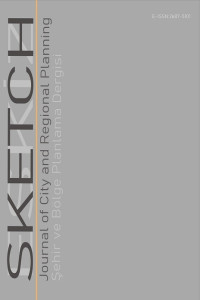Kendileme’ Odağında Kentte Yürümenin Mekânsal Topolojisi: Van Örneğinde Alt Yürüme Bölgeleri
Kentin bedenimize de zihnimize de biz farkında olmadan sürekli dokunduğu en gündelik deneyim yürümektir. ‘Yürüme edimi’ müşterek mekânı sahiplenme ve işaretleme pratiklerimizden de en temel olanıdır. Bu çalışma, yürüyen bireyin müşterek mekânı, durma-hareket etme ikilemi içinde nasıl anlamlandırdığına ve kendilediğine odaklanarak, Van’da gözlenen farklı yürüme bölgelerini ortaya çıkarmayı hedeflemektedir. Araştırma sorusu, Lynch’in metodolojik kent imgesi kavramlarının Seamon’un kuramsal yere bağlanma çerçevesiyle sentezlenmesi yoluyla, Van örneğinde 2016-1018 yıllarında yapılan ön gözlemlere ek olarak Van Yüzüncü Yıl Üniversitesi Mimarlık Fakültesi mimarlık ve planlama öğrencileriyle 2016-2020 yılları arasında yapılan ders içi çalışmalar, 2020 yılı bahar döneminde Kent, İnsan ve Çevre dersi bünyesinde yapılan derin görüşmeler ve toplanan zihinsel haritalar aracılığıyla yanıtlanacaktır. Yürüme bağlamında ayrışan kentsel alt bölgeleri fark etmek, politika ve tasarım süreçlerine girdi oluşturacak, daha nitelikli ve ait hissedilen yaya bölgeleri oluşturmanın kapısını aralayacaktır.
Anahtar Kelimeler:
Sokak, Yürüme Edimi, Kent İmgesi, Kendileme, Psikocoğrafya, Van
Spatial Topology of Walking through 'Appropriation': Sub-regions of Walking in the Case of Van
Walking is an urban experience through which the urban space penetrates both our body and mind although we usually do not sense. Moreover, it is the most basic activity of marking and possessing urban common spaces. This study concentrates on how a walking body perceives, and possesses pattern of urban common spaces via his/her movements and pauses in Van case and aims to reveal differentiated walking districts. The research question will be answered via a synthesis of Kevin Lynch’s City Image perspective and six processes of place attachment and appropriation presented by David Seamon, analysing the small cases and student studies from 2016 to 2020, especially the mental maps and narratives collected from second grade city planning students in Van Yüzüncü Yıl University in addition to the pre-observations conducted during 2016-2018. Recognizing the differentiated urban regions via the activity of walking would create a path to take an input for policy and design processes to produce more qualitative and possessed pedestrian zones in the city.
Keywords:
Street, Walking, Image of the City, Spatial Appropriation, Psychogeography, Van,
___
- Altman, I. ve Low, S. M., eds. 1992. Place Attachment. New York: Plenum.
- De Certeau, M. 1984. The Practice of Everyday Life. Translated by Steven Rendell. Berkley: University of California.
- Bildiri Metni: Kentte Bedenin Oluşturduğu Ev. (9.9.2011) http://www.depolarla.blogspot.com. Kentsel Konut, Yeniden Bugün, İstanbul Konulu Mimari Tasarım Stüdyosu Çalışma Ve Depolama Alanı.
- Gehl, J. 2011. Life Between Buildings: Using Public Space. USA: Island Press.
- Göregenli, M. 2010. Çevre Psikolojisi – İnsan Mekân İlişkileri. İstanbul: İstanbul Bilgi Üniversitesi Yayınları.
- Gros, F. 2017. Yürümenin Felsefesi. İstanbul: Kolektif Kitap.
- Hillier, B. ve Hanson J. 1984. The Social Logic of Space. Great Britain: Cambridge University of Press.
- Hillier, B. 1996. Space is the Machine: A Configurational Theory of Architecture. Great Britain: Cambridge University of Press.
- Isaacs, R. 2010. “The Urban Picturesque: An Aesthetic Experience of Urban Pedestrian Places.” Journal of Urban Design 5 (2): 145-180.
- Jacobs, J. 2011. Büyük Amerikan Şehirlerinin Ölümü ve Yaşamı [Orijinal adı: The Death and Life of Great American Cities]. İstanbul: Metis Yayınları.
- Jiang, B., ve Omer, I. 2007. “Spatial Topology and Its Structural Analysis based on the Concept of Simplicial Complex.” Transactions in GIS 11 (6):943-960.
- İlkay, Y. 2018. “Liveliness Pattern of Van City Centre (Bazaar) from the Viewpoint of Flâneur/Flâneuse: Spatial Topology of Two Main Axes with Open and Green Areas.” chp.12., Cultural Landscape of Van, Turkey (e-book) içinde, (Editörler: Dr. Gökçen Firdevs Yücel Caymaz, Prof.Dr. Bilge Işık), 168-183. İstanbul: İstanbul Aydın University Publications.
- İlkay, Y. ve Keleş Eriçok A. 2018. “Sosyal Ve Kültürel Sürdürülebilirlik Ekseninde Van’da Kentsel Sahiplenme Potansiyelleri.” II. Uluslararası Şehir, Çevre ve Sağlık Kongresi, Nisan 16-20, 2018, Ürgüp/Kapadokya.
- Lefebvre, H. 1991. Production of Space. Oxford: Balackwell.
- Lewicka, M. 2011. “Place Attachment: How far have we come in the last 40 years?.” Journal of Environmental Psychology Vol. 31: 207-230.
- Lynch, K. 2010. Kent İmgesi. İstanbul: Türkiye İş Bankası Yayınları/Kültür Yayınları.
- Manzo L. C. Ve Wright P. 2013. “Introduction.” Place Attachment içinde (der. Manzo ve Wright). London & New York: Routledge.
- Mehta, V. 2008. “Walkable Streets: Pedestrian Behaviour, Perceptions and Attitudes.” Journal of Urbanism 1 (3): 217-249.
- Pamuk, O. 2013. İstanbul Hatıralar ve Şehir. İstanbul: YKY.
- Paquot, T. 2011. Şehirsel Bedenler: Beton ile Asfalt Arası(nda) Hassasiyetler. İstanbul: Everest Yayınları/Satırarası.
- Ratti, C. 2004. “Urban Texture and Space Syntax: Some Inconsistencies.” Environment and Planning B: Planning and Design Vol. 31.
- Scannel, L. ve Gifford, R. 2010. “Defining Place Attachment: A Tripartite Organizing Framework.” Journal of Environmental Psychology 30: 1-10.
- Seamon, D. 2013. “Place Attachment and Phenomenology, The Synergistic Dynamism of Place.” Place Attachment içinde (der. Manzo ve Wright). London & New York: Routledge.
- Sennett, R. 2008. Ten ve Taş: Batı Uygarlığında Beden ve Şehir [Orijinal adı: Flesh and Stone: The Body and the City in Western Civilization (1994)]. İstanbul: Metis Yayınları.
- Simonsen, K. 2005. “Bodies, Sensations, Space and Time: The Contribution from Henri Lefebvre.” Geogr. Ann. 87 B (1): 1-14.
- Şahin Yeşil S. 2016. “Psikocoğrafya ve Bir Şehir Gezginin Anıları.” Monograf içinde, Edebiyat Eleştiri Dergisi 2016/5: 124-149.
- Tanpınar, A. H. 1960. İstanbul, Beş Şehir. Ankara: İş Bankası Yayınları.
- Tversky, B. 2003. “Structures of mental spaces.” Environment and Behaviour 35 (1): 66-80.
- Werner, S. ve Schindler, L. E. 2004. “The Role of Spatial Reference Frames in Architecture.” Environment and Behaviour 36 (4): 217-249.
- Başlangıç: 2019
- Yayıncı: Mersin Üniversitesi
Sayıdaki Diğer Makaleler
Kentsel Dönüşümü Mamak Örneği Üzerinden Anlamak- Kentsel Dönüşüm İçin Yeni Bir Bakış Açısı
Kendileme’ Odağında Kentte Yürümenin Mekânsal Topolojisi: Van Örneğinde Alt Yürüme Bölgeleri
Türkiye’deki Mega Projeler-Mekânsal Planlama Gerilimi
Akıllı Kentlerin Gelişimi ve Kent Planlama İlişkisi Üzerine Bir Değerlendirme
